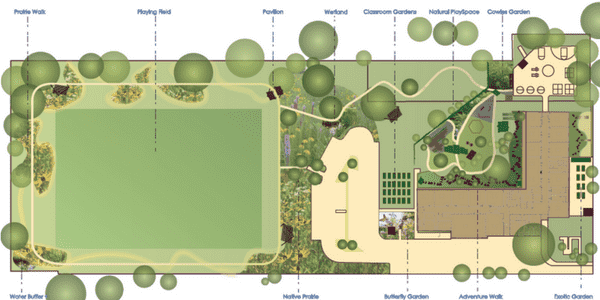Students at Cowles Montessori, a pre-K through 8th grade public school, range in age from three to 13. Creating one outdoor learning environment to serve such a wide age range is a daunting challenge, so the school chose to develop a long-term master garden plan first.
“Our goal for year one was just to create the master plan,” Principal Gregory Grylls explains. “We worked with landscape architects through Iowa State University to develop and create it. Now that the plan is complete, we consider it a five-year plan, although it will continue to evolve.”
A master plan emphasizes research first and promotes thoughtful, steady execution. Depending on a school’s site- and program-specific needs, some common key components of a master garden plan may include:
- Site survey and/or environmental assessment
- Landscaping, garden design and irrigation plans
- Design plans for adjacent outdoor areas, playgrounds or other related structures
- Long-term goals and objectives
- Phased project plans
- Materials lists
- Labor and volunteer needs
- Budgets
- Timelines
Researching and documenting all of this at once makes it easier to coordinate separate projects or phases over time, so resources get allocated more efficiently and effectively.
The Cowles master plan encompasses their entire outdoor space, including the garden; the playground; an area in between, which they’ve named the “adventure walk;” a native prairie garden; a butterfly garden; and several other gardens and structures that surround an adjacent playing field. The plan includes as many details as possible, such as where to place certain plants and trees, who will be responsible for each garden bed, which direction the slide should aim, and many other specifics.
“Our school-wide master garden plan helps us have a more sustainable program,” Grylls explains. “Our garden committee includes parents, teachers and students. Having the voice of all those stakeholders has been key in creating the plan. Now our program is not dependent on a single teacher keeping it up over the years.”
“Our school-wide master garden plan helps us have a more sustainable program.”
When stakeholders all share the same vision for the future, it’s a lot easier to build broad community support, and there is less risk of losing momentum when a single person leaves or steps out of the process.
A master garden plan is also an excellent tool for communication and accountability. It can be cited to justify funding, show the rate of progress or improvements, and demonstrate proper allocation of resources and budgets.
“We are a public school and part of a large district, so there are certain things we can and can’t do,” Grylls explains. “We have to tie the funds used for our garden back into the curriculum. Being able to show them our master plan makes it a lot easier to have those conversations at the district level.”
And the plan makes it easier to identify grant opportunities that will further the work, instead of straying from it.
“We can be more intentional about the grants we pursue,” Grylls says. “There are all these random grants out there. In the past, we applied for and received one having to do with birdhouses. Well, that’s great, but how do birdhouses fit into our plan?”
The master plan also helps the Cowles garden committee function more systematically. Each month, they meet to assess progress, review goals and divvy up task lists. In between meetings, each member collects feedback and new ideas from their constituents.
Teachers gather input from their grade-level teams to make sure curriculum goals are supported. Students and volunteers work on garden projects—they recently completed the first phase of the master plan, which involved new garden beds. Parents reach out into the community to fulfill specific volunteer and donation needs.
Donors and volunteers like to know specifically where their money and efforts will go, and the master plan’s clear framework makes it a lot easier to communicate that.
Grylls says: “Rather than asking people to donate to our garden in general, we’re able to say, ‘Look, this is our master plan. We need x, y and z. Can you help?’ This master plan has become the voice of our community.”
Interested in creating your own master garden plan? Contact your nearest agricultural county extension office or USDA Service Center. Also consider reaching out to a nearby master gardener, college or university for research and assistance.



